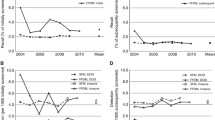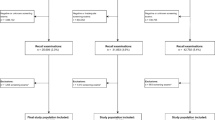Abstract
Objective
The aim of this study was to retrospectively determine screening outcome in women recalled twice for the same mammographic lesion before, during, and after transition from screen-film (SFM) to full-field digital screening mammography (FFDM).
Methods
We included women with a repeated recall for the same mammographic abnormality (37 at subsequent SFM-screening, obtained between January 2000-April 2010; respectively 54 and 65 women with a prior SFM-screen or FFDM-screen followed by subsequent FFDM-screening, obtained between May 2009-July 2013).
Results
At SFM-screening, repeated recalls for the same lesion comprised 1.2 % of recalls (37/3217), including 13 malignancies (positive predictive value (PPV), 35.1 %). During the SFM to FFDM transition (SFM-screen followed by FFDM-screen), FFDM recalls comprised more repeated recalls for the same lesion (2.2 %, P = 0.002), with a lower PPV (14.8 %, P = 0.02). This proportion increased to 2.8 % after transition to FFDM (i.e., two successive FFDM-screens), with 16 malignancies (PPV, 24.6 %). Invasive cancers at repeated recall were smaller than interval cancers (T1a-c, 79.4 versus 46.8 %, P = 0.001), with less lymph node involvement (20.6 versus 46.5 %, P = 0.007).
Conclusions
More women are repeatedly recalled for the same mammographic abnormality during and after the transition from SFM to FFDM-screening, with comparable cancer risks before and after the transition. These cancers show better prognostic characteristics than interval cancers.
Key Points
• FFDM-screening increases the number of repeated recalls for the same mammographic abnormality.
• The PPV of these recalls is comparable before and after transition to FFDM-screening.
• Cancers diagnosed after a repeated recall are smaller than interval cancers.
• These cancers also show less lymph node involvement than interval cancers.


Similar content being viewed by others
References
Dowling EC, Klabunde C, Patnick J, Ballard-Barbash R (2010) Breast and cervical cancer screening programme implementation in 16 countries. J Med Screen 17:139–146
Saadatmand S, Bretveld R, Siesling S, Tilanus-Linthorst MMA (2015) Influence of tumour stage at breast cancer detection on survival in modern times: population based study in 173797 patients. BMJ 351:h4901
Pisano ED, Gatsonis C, Hendrick E et al (2005) Diagnostic performance of digital versus film mammography for breast-cancer screening. N Engl J Med 353:1773–1783
Skaane P, Skjennald A (2004) Screen-film mammography versus full-field digital mammography with soft copy reading: Randomized trial in a population based screening program - The Oslo II study. Radiology 232:197–204
Nederend J, Duijm LEM, Louwman MWJ, Groenewoud JH, Donkers-van Rossum AB, Voogd AC (2012) Impact of the transition from analog screening mammography to digital screening mammography on screening outcome in the Netherlands: a population-based study. Ann Oncol 23:3098–3103
van Luijt PA, Fracheboud J, Heijnsdijk EA, den Heeten GJ, de Koning HJ (2013) Nation-wide data on screening performance during the transition to digital mammography: Observations in 6 million screens. Eur J Cancer 49:3517–3525
Hambly NM, McNicholas MM, Phelan N, Hargaden GC, O’Doherty A, Flanagan FL (2009) Comparison of digital mammography and screen-film mammography in breast cancer screening: a review in the irish breast screening program. AJR Am J Roentgenol 193:1010–1018
Karssemeijer N, Bluekens AM, Beijerinck D et al (2009) Breast cancer screening results 5 years after introduction of digital mammography in a population-based screening program. Radiology 253:353–358
Setz-Pels W, Duijm LEM, Louwman MW, Roumen RM, Jansen F, Voogd AC (2012) Characteristics and screening outcome of women referred twice at screening mammography. Eur Radiol 22:2624–2632
Raja MA, Hubbard A, Salman AR (2001) Interval breast cancer: is it a different type of breast cancer? Breast 10:100–108
Duijm LE, Groenewoud JH, de Koning HJ et al (2009) Delayed diagnosis of breast cancer in women recalled for suspicious screening mammography. Eur J Cancer 45:774–781
Vitak B, Olsen KE, Manson JC, Arnesson LG, Stal O (1999) Tumour characteristics and survival in patients with invasive interval breast cancer classified according to mammographic findings at the latest screening: a comparison of true interval and missed interval cancers. Eur Radiol 9:460–469
Hofvind S, Geller B, Skaane P (2008) Mammographic features and histopathological findings of interval breast cancers. Acta Radiol 49:975–981
Domingo L, Sala M, Servitja S et al (2010) Phenotypic characterization and risk factors for breast cancers in a population-based breast cancer screening program in Barcelona, Spain. Cancer Causes Control 21:1155–1164
Klompenhouwer EG, Duijm LE, Voogd AC et al (2014) Re-attendance at biennial screening mammography following a repeated false positive recall. Breast Cancer Res Treat 145:429–437
Fracheboud J, de Koning HJ, Boer R et al (2001) Nationwide breast cancer screening programme fully implemented in The Netherlands. Breast 10:6–11
Maes RM, Dronkers DJ, Hendriks JH, Thijssen MA, Nab HW (1997) Do non-specific minimal signs in a biennial mammographic breast cancer screening programme need further diagnostic assessment? Br J Radiol 70:34–38
American College of Radiology (2003) Breast Imaging Reporting and Data System (BI-RADS), 4th edn. American College of Radiology, Reston
Nederend J, Duijm LE, Louwman MW, Jansen FH, Voogd AC (2014) Trends in the surgical management of screen detected cancers and interval cancers in a Dutch screening mammography program and risk factors for positive tumour positive resection margins after breast conserving treatment. Br J Surg 101:949–958
Setz-Pels W, Duijm LE, Coebergh JW, Rutten M, Nederend J, Voogd AC (2013) Re-attendance after false positive screening mammography; a population based study in the Netherlands. Br J Cancer 109:2044–2050
Richards MA, Westcombe AM, Littlejohns P, Ramirez AJ (1999) Influence of delay on survival in patients with breast cancer: a systematic review. Lancet 353:1119–1126
Allgood PC, Duffy SW, Warren R, Hunnam G (2006) Audit of negative assessments in a breast-screening programme in women who later develop breast cancer – implications for survival. Breast 15:503–509
Hoff SR, Abrahamsen AL, Samset JH, Vigeland E, Klepp O, Hofvind S (2012) Breast cancer: missed interval and screening-detected cancer at full-field digital mammography and screen film mammography – results from a retrospective review. Radiology 264:378–386
Nederend J, Duijm LE, Louwman MW et al (2014) Impact of the transition from screen-film to digital screening mammography on interval cancer characteristics and treatment – a population based study from the Netherlands. Eur J Cancer 50:31–39
Henderson LM, Miglioretti DL, Kerlikowske K, Wernli KJ, Sprague BL, Lehman CD (2015) Breast cancer characteristics associated with digital versus film-screen mammography for screen-detected and interval cancers. AJR Am J Roentgenol 205:676–684
Shin HC, Han W, Moon HG et al (2013) Breast-conserving surgery after tumour downstaging by neoadjuvant chemotherapy is oncologically safe for stage III breast cancer patients. Ann Surg Oncol 20:2582–2589
Fitzal F, Mittlboeck M, Steger G et al (2012) Neoadjuvant chemotherapy increases the rate of breast conservation in lobular-type breast cancer patients. Ann Surg Oncol 19:519–526
Caudle AS, Gonzalez-Angulo AM, Hunt KK et al (2011) Impact of progression during neoadjuvant chemotherapy on surgical management of breast cancer. Ann Surg Oncol 18:932–938
Acknowledgments
The scientific guarantor of this publication is Lucien EM Duijm, M.D., Ph.D.. The authors of this manuscript declare no relationships with any companies, whose products or services may be related to the subject matter of the article. The authors state that this work has not received any funding. No complex statistical methods were necessary for this paper. The Central Committee on Research Involving Human Subjects (CCMO) in The Hague, The Netherlands, waived ethical approval for this study. Women participating in our screening program are asked to give permission for the use of their data for quality assurance and scientific purposes. Four women screened at our units did not give this permission and they were excluded from analysis. No study subjects or cohorts have been previously reported. Methodology: prospective, observational, multicenter study / performed at one institution (one group of screening radiologists; assessment of recalled women at multiple institutions).
Author information
Authors and Affiliations
Corresponding author
Rights and permissions
About this article
Cite this article
van Bommel, R., Voogd, A.C., Louwman, M.W. et al. Screening outcome in women repeatedly recalled for the same mammographic abnormality before, during and after the transition from screen-film to full-field digital screening mammography. Eur Radiol 27, 553–561 (2017). https://doi.org/10.1007/s00330-016-4399-y
Received:
Revised:
Accepted:
Published:
Issue Date:
DOI: https://doi.org/10.1007/s00330-016-4399-y




